Macroeconomics Report: Impact of Trade Wars and Monetary Policies
VerifiedAdded on 2022/09/06
|13
|2463
|16
Report
AI Summary
This macroeconomics report examines the impact of the US-China trade war on the global and Australian economies, highlighting the decline in manufacturing and reduced GDP growth estimations. It discusses key macroeconomic objectives like full employment, price stability, economic growth, and balance of payments, analyzing their relevance to Australia's economic performance. The report explores Australia's GDP growth, inflation rates, and exchange rate fluctuations, linking them to the country's trade dependency on China. It further analyzes the Reserve Bank of Australia's (RBA) monetary policies, including cash rate cuts, and their effects on the economy, including the implications of expansionary and contractionary monetary policies on investment, inflation, and the housing market. The report concludes with an assessment of the consequences of currency appreciation on Australia's housing sector and overall economic output.
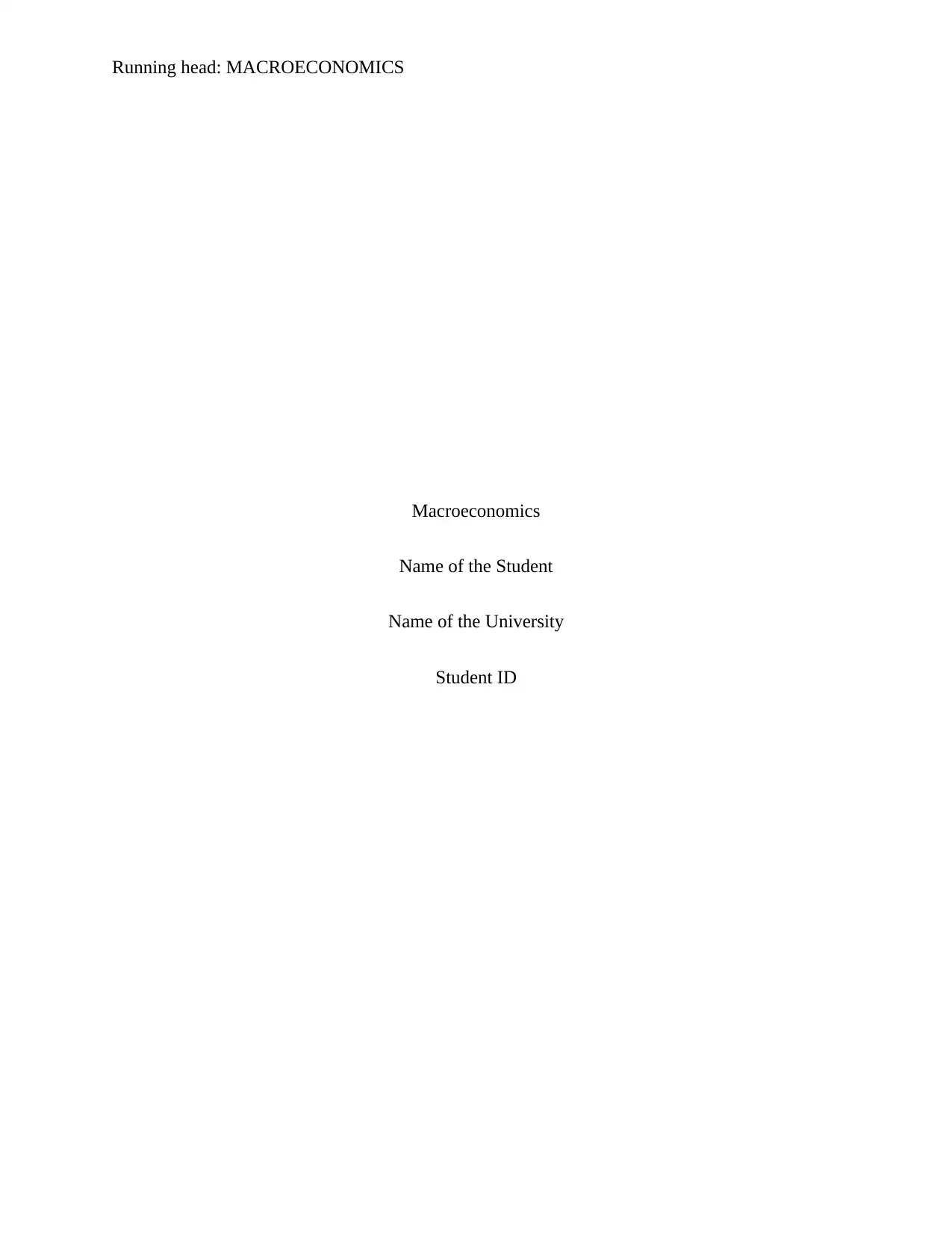
Running head: MACROECONOMICS
Macroeconomics
Name of the Student
Name of the University
Student ID
Macroeconomics
Name of the Student
Name of the University
Student ID
Paraphrase This Document
Need a fresh take? Get an instant paraphrase of this document with our AI Paraphraser
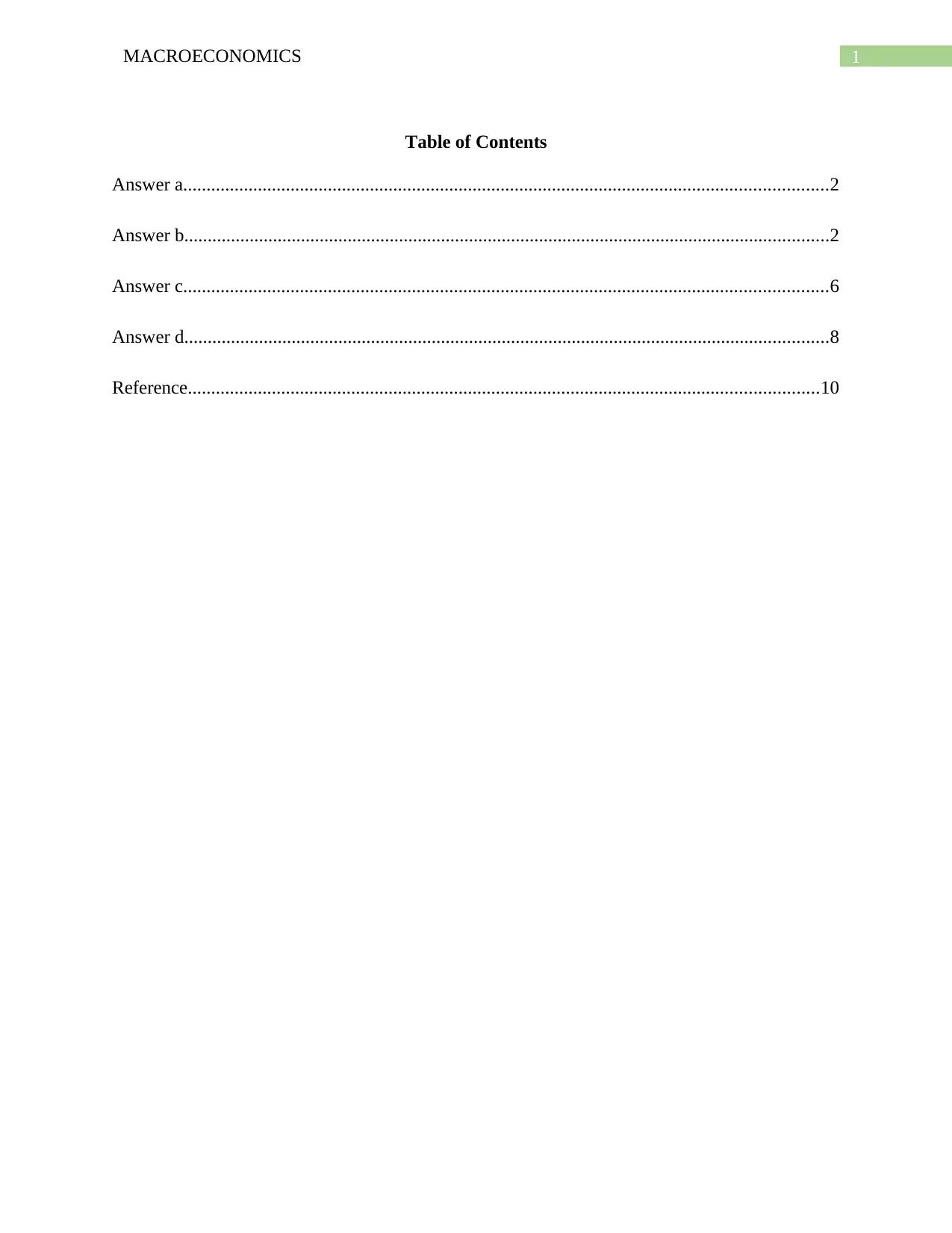
1MACROECONOMICS
Table of Contents
Answer a..........................................................................................................................................2
Answer b..........................................................................................................................................2
Answer c..........................................................................................................................................6
Answer d..........................................................................................................................................8
Reference.......................................................................................................................................10
Table of Contents
Answer a..........................................................................................................................................2
Answer b..........................................................................................................................................2
Answer c..........................................................................................................................................6
Answer d..........................................................................................................................................8
Reference.......................................................................................................................................10
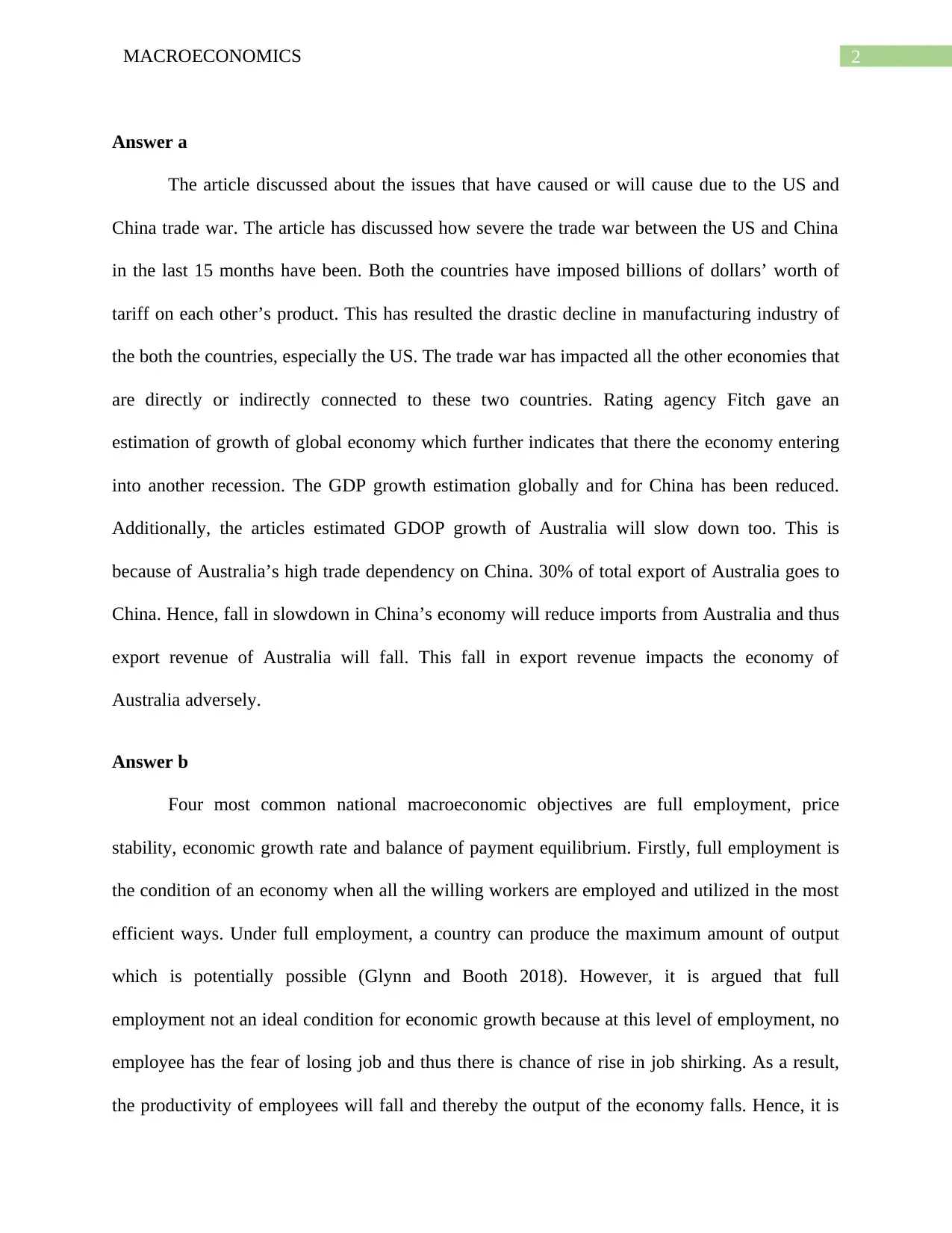
2MACROECONOMICS
Answer a
The article discussed about the issues that have caused or will cause due to the US and
China trade war. The article has discussed how severe the trade war between the US and China
in the last 15 months have been. Both the countries have imposed billions of dollars’ worth of
tariff on each other’s product. This has resulted the drastic decline in manufacturing industry of
the both the countries, especially the US. The trade war has impacted all the other economies that
are directly or indirectly connected to these two countries. Rating agency Fitch gave an
estimation of growth of global economy which further indicates that there the economy entering
into another recession. The GDP growth estimation globally and for China has been reduced.
Additionally, the articles estimated GDOP growth of Australia will slow down too. This is
because of Australia’s high trade dependency on China. 30% of total export of Australia goes to
China. Hence, fall in slowdown in China’s economy will reduce imports from Australia and thus
export revenue of Australia will fall. This fall in export revenue impacts the economy of
Australia adversely.
Answer b
Four most common national macroeconomic objectives are full employment, price
stability, economic growth rate and balance of payment equilibrium. Firstly, full employment is
the condition of an economy when all the willing workers are employed and utilized in the most
efficient ways. Under full employment, a country can produce the maximum amount of output
which is potentially possible (Glynn and Booth 2018). However, it is argued that full
employment not an ideal condition for economic growth because at this level of employment, no
employee has the fear of losing job and thus there is chance of rise in job shirking. As a result,
the productivity of employees will fall and thereby the output of the economy falls. Hence, it is
Answer a
The article discussed about the issues that have caused or will cause due to the US and
China trade war. The article has discussed how severe the trade war between the US and China
in the last 15 months have been. Both the countries have imposed billions of dollars’ worth of
tariff on each other’s product. This has resulted the drastic decline in manufacturing industry of
the both the countries, especially the US. The trade war has impacted all the other economies that
are directly or indirectly connected to these two countries. Rating agency Fitch gave an
estimation of growth of global economy which further indicates that there the economy entering
into another recession. The GDP growth estimation globally and for China has been reduced.
Additionally, the articles estimated GDOP growth of Australia will slow down too. This is
because of Australia’s high trade dependency on China. 30% of total export of Australia goes to
China. Hence, fall in slowdown in China’s economy will reduce imports from Australia and thus
export revenue of Australia will fall. This fall in export revenue impacts the economy of
Australia adversely.
Answer b
Four most common national macroeconomic objectives are full employment, price
stability, economic growth rate and balance of payment equilibrium. Firstly, full employment is
the condition of an economy when all the willing workers are employed and utilized in the most
efficient ways. Under full employment, a country can produce the maximum amount of output
which is potentially possible (Glynn and Booth 2018). However, it is argued that full
employment not an ideal condition for economic growth because at this level of employment, no
employee has the fear of losing job and thus there is chance of rise in job shirking. As a result,
the productivity of employees will fall and thereby the output of the economy falls. Hence, it is
⊘ This is a preview!⊘
Do you want full access?
Subscribe today to unlock all pages.

Trusted by 1+ million students worldwide

3MACROECONOMICS
suggested that an unemployment rate of 4.5% is ideal for an economy to operate efficiently.
Secondly, price stability is an important macroeconomic factor because unstable price fluctuates
the inflation rate since percentage rise in price is known as inflation rate. From law of demand
and supply it is known that with rise in price demand for goods fall. Hence, excessive inflation
reduces the aggregate demand for goods and services in an economy decreases which further
reduces the business confidence and causes aggregate supply to fall. Consequently, the total
output of the economy declines causing fall in economic growth. Thirdly, economic growth rate
is the percentage increase in overall output of an economy. It is often referred as GDP growth
rate. Every country wants to earn more and for increase in GDO is important (Gonzalez Minguez
and Martinez-Carrascal 2019). With continuous rise in GDP of country, its economy expands
causing growth of the economy. Economic growth increases the income of individuals of an
economy too. Along with that consumer confidence and business confidence increases which
further contributes to rise in consumption and investment. Therefore, for development of
economy of a country economic growth is necessary. Fourthly, balance of payments is the
account of total international transactions made by residents of country. It includes all the capital
outflows and capital inflows occurred in a country. With more capital inflows than capital
outflows the balance of payment of a country increases, which is known as balance of payments
surplus. Similarly, with more capital outflows than inflows balance of payment decrease, which
is termed as balance of payment deficit. There is no significant impact of change in balance of
payment in the short term.
Australia is prosperous economy and it has shown good rate of growth over the years but
in the recent years, there is a decline in the GDP growth rate of the country. It can be seen figure
1 that until mid of 2018 there was upward trend in the GDP growth of Australia. However, after
suggested that an unemployment rate of 4.5% is ideal for an economy to operate efficiently.
Secondly, price stability is an important macroeconomic factor because unstable price fluctuates
the inflation rate since percentage rise in price is known as inflation rate. From law of demand
and supply it is known that with rise in price demand for goods fall. Hence, excessive inflation
reduces the aggregate demand for goods and services in an economy decreases which further
reduces the business confidence and causes aggregate supply to fall. Consequently, the total
output of the economy declines causing fall in economic growth. Thirdly, economic growth rate
is the percentage increase in overall output of an economy. It is often referred as GDP growth
rate. Every country wants to earn more and for increase in GDO is important (Gonzalez Minguez
and Martinez-Carrascal 2019). With continuous rise in GDP of country, its economy expands
causing growth of the economy. Economic growth increases the income of individuals of an
economy too. Along with that consumer confidence and business confidence increases which
further contributes to rise in consumption and investment. Therefore, for development of
economy of a country economic growth is necessary. Fourthly, balance of payments is the
account of total international transactions made by residents of country. It includes all the capital
outflows and capital inflows occurred in a country. With more capital inflows than capital
outflows the balance of payment of a country increases, which is known as balance of payments
surplus. Similarly, with more capital outflows than inflows balance of payment decrease, which
is termed as balance of payment deficit. There is no significant impact of change in balance of
payment in the short term.
Australia is prosperous economy and it has shown good rate of growth over the years but
in the recent years, there is a decline in the GDP growth rate of the country. It can be seen figure
1 that until mid of 2018 there was upward trend in the GDP growth of Australia. However, after
Paraphrase This Document
Need a fresh take? Get an instant paraphrase of this document with our AI Paraphraser
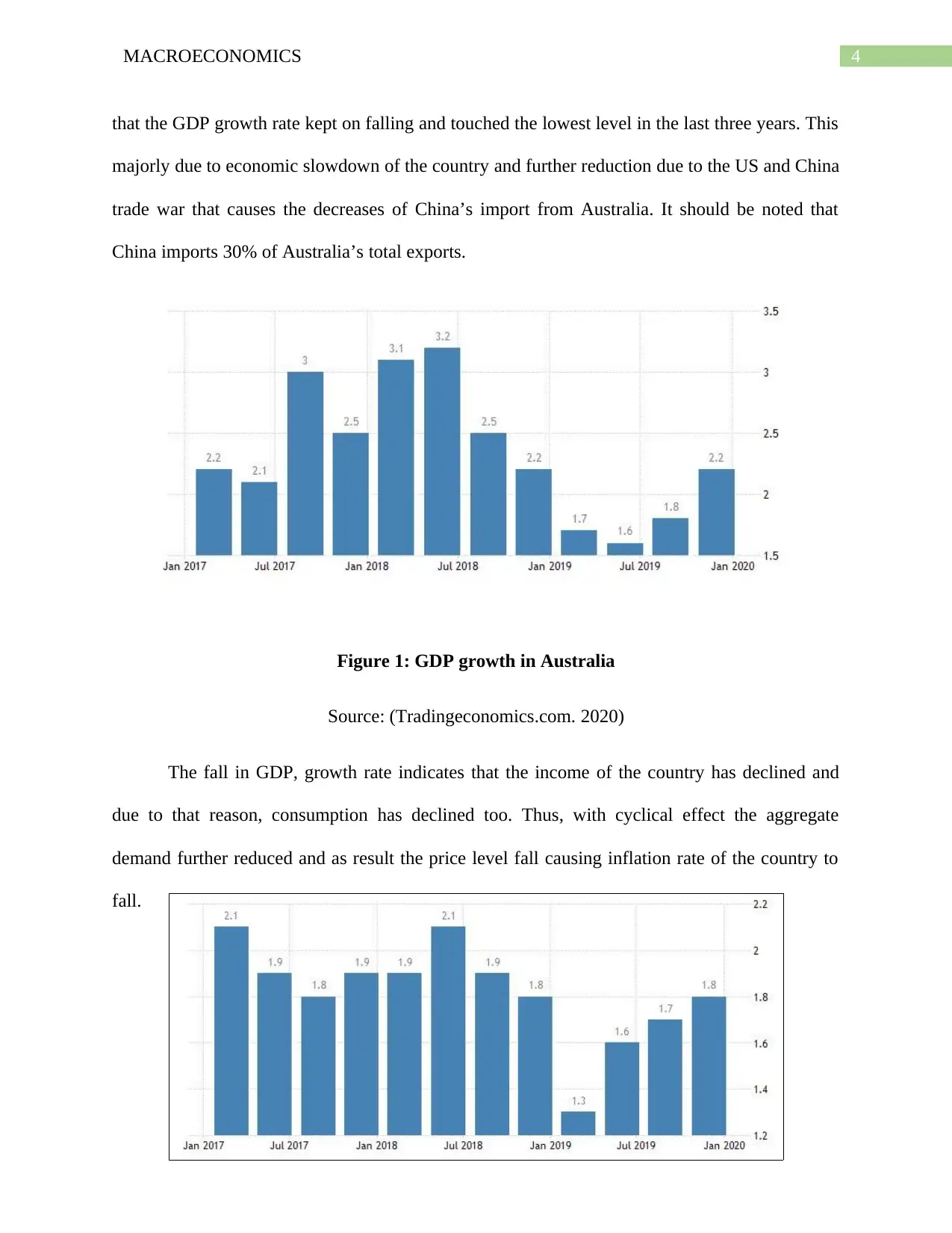
4MACROECONOMICS
that the GDP growth rate kept on falling and touched the lowest level in the last three years. This
majorly due to economic slowdown of the country and further reduction due to the US and China
trade war that causes the decreases of China’s import from Australia. It should be noted that
China imports 30% of Australia’s total exports.
Figure 1: GDP growth in Australia
Source: (Tradingeconomics.com. 2020)
The fall in GDP, growth rate indicates that the income of the country has declined and
due to that reason, consumption has declined too. Thus, with cyclical effect the aggregate
demand further reduced and as result the price level fall causing inflation rate of the country to
fall.
that the GDP growth rate kept on falling and touched the lowest level in the last three years. This
majorly due to economic slowdown of the country and further reduction due to the US and China
trade war that causes the decreases of China’s import from Australia. It should be noted that
China imports 30% of Australia’s total exports.
Figure 1: GDP growth in Australia
Source: (Tradingeconomics.com. 2020)
The fall in GDP, growth rate indicates that the income of the country has declined and
due to that reason, consumption has declined too. Thus, with cyclical effect the aggregate
demand further reduced and as result the price level fall causing inflation rate of the country to
fall.
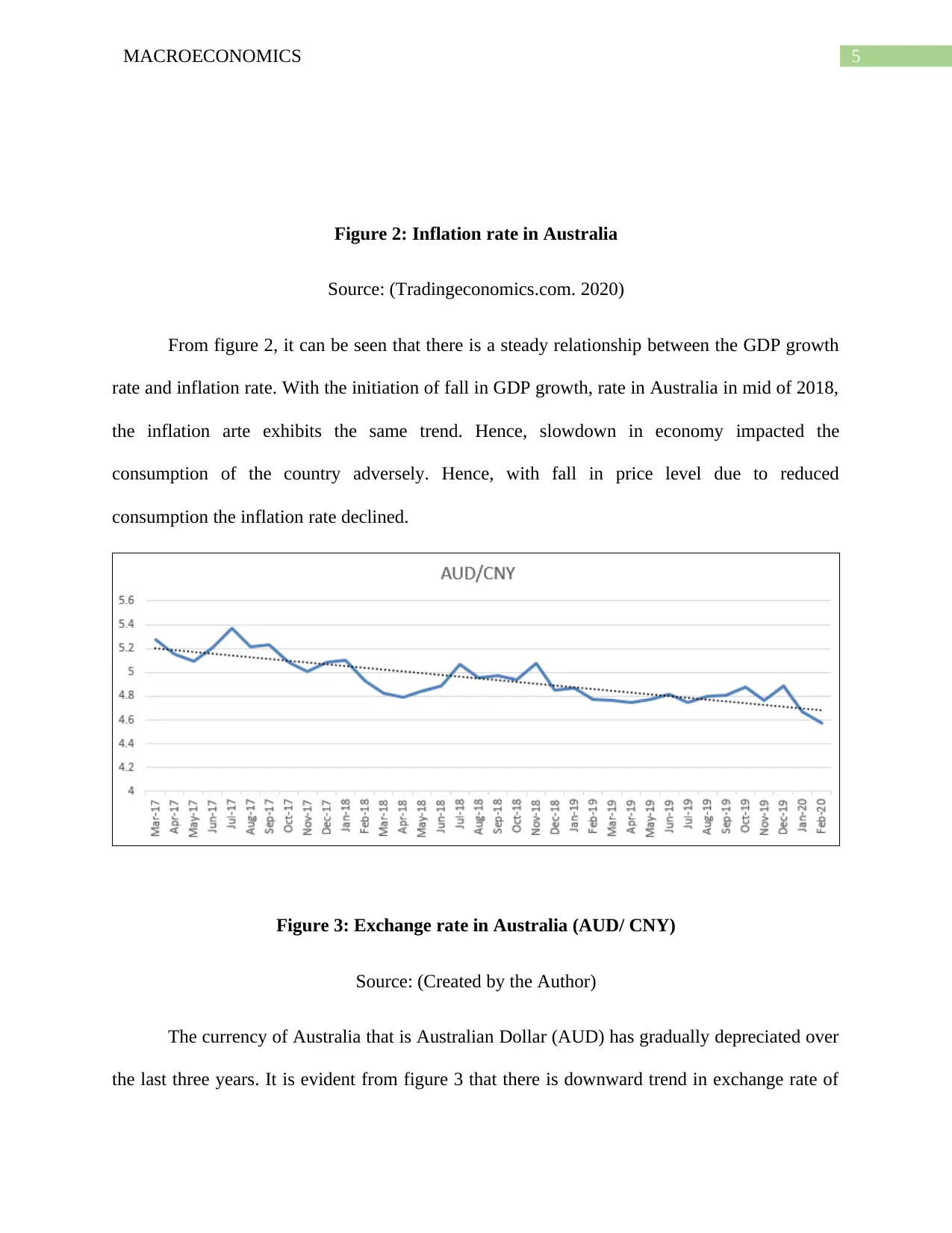
5MACROECONOMICS
Figure 2: Inflation rate in Australia
Source: (Tradingeconomics.com. 2020)
From figure 2, it can be seen that there is a steady relationship between the GDP growth
rate and inflation rate. With the initiation of fall in GDP growth, rate in Australia in mid of 2018,
the inflation arte exhibits the same trend. Hence, slowdown in economy impacted the
consumption of the country adversely. Hence, with fall in price level due to reduced
consumption the inflation rate declined.
Figure 3: Exchange rate in Australia (AUD/ CNY)
Source: (Created by the Author)
The currency of Australia that is Australian Dollar (AUD) has gradually depreciated over
the last three years. It is evident from figure 3 that there is downward trend in exchange rate of
Figure 2: Inflation rate in Australia
Source: (Tradingeconomics.com. 2020)
From figure 2, it can be seen that there is a steady relationship between the GDP growth
rate and inflation rate. With the initiation of fall in GDP growth, rate in Australia in mid of 2018,
the inflation arte exhibits the same trend. Hence, slowdown in economy impacted the
consumption of the country adversely. Hence, with fall in price level due to reduced
consumption the inflation rate declined.
Figure 3: Exchange rate in Australia (AUD/ CNY)
Source: (Created by the Author)
The currency of Australia that is Australian Dollar (AUD) has gradually depreciated over
the last three years. It is evident from figure 3 that there is downward trend in exchange rate of
⊘ This is a preview!⊘
Do you want full access?
Subscribe today to unlock all pages.

Trusted by 1+ million students worldwide
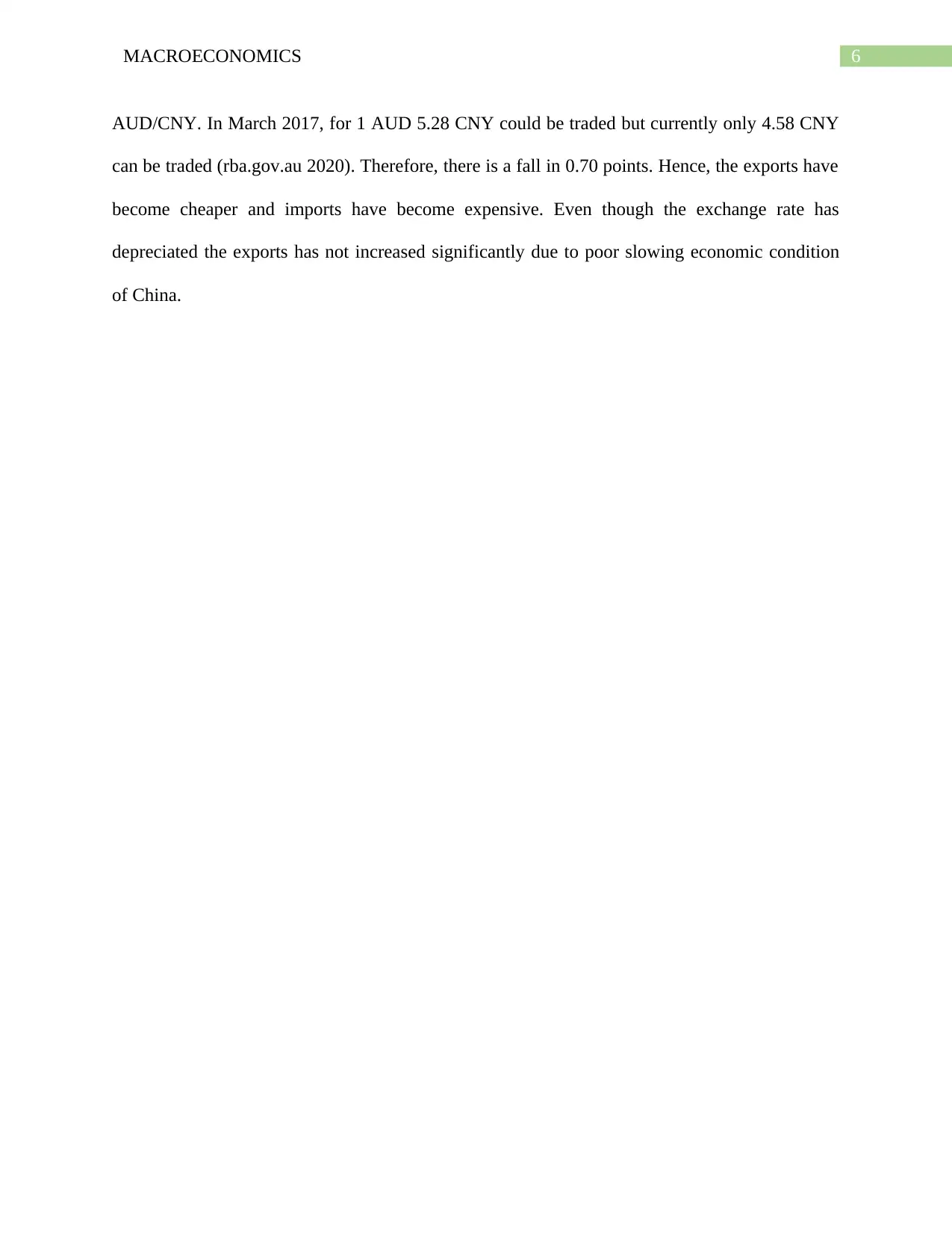
6MACROECONOMICS
AUD/CNY. In March 2017, for 1 AUD 5.28 CNY could be traded but currently only 4.58 CNY
can be traded (rba.gov.au 2020). Therefore, there is a fall in 0.70 points. Hence, the exports have
become cheaper and imports have become expensive. Even though the exchange rate has
depreciated the exports has not increased significantly due to poor slowing economic condition
of China.
AUD/CNY. In March 2017, for 1 AUD 5.28 CNY could be traded but currently only 4.58 CNY
can be traded (rba.gov.au 2020). Therefore, there is a fall in 0.70 points. Hence, the exports have
become cheaper and imports have become expensive. Even though the exchange rate has
depreciated the exports has not increased significantly due to poor slowing economic condition
of China.
Paraphrase This Document
Need a fresh take? Get an instant paraphrase of this document with our AI Paraphraser
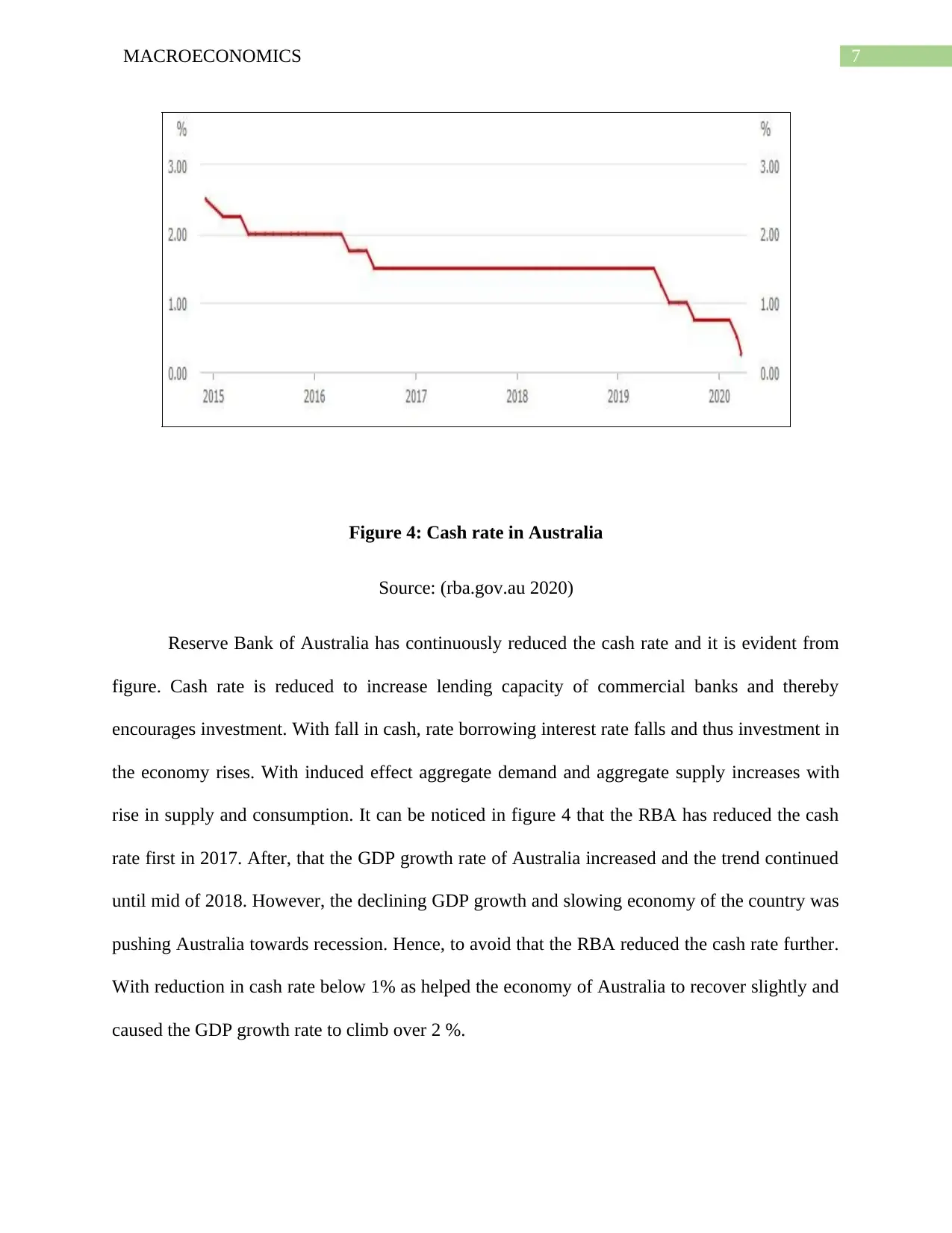
7MACROECONOMICS
Figure 4: Cash rate in Australia
Source: (rba.gov.au 2020)
Reserve Bank of Australia has continuously reduced the cash rate and it is evident from
figure. Cash rate is reduced to increase lending capacity of commercial banks and thereby
encourages investment. With fall in cash, rate borrowing interest rate falls and thus investment in
the economy rises. With induced effect aggregate demand and aggregate supply increases with
rise in supply and consumption. It can be noticed in figure 4 that the RBA has reduced the cash
rate first in 2017. After, that the GDP growth rate of Australia increased and the trend continued
until mid of 2018. However, the declining GDP growth and slowing economy of the country was
pushing Australia towards recession. Hence, to avoid that the RBA reduced the cash rate further.
With reduction in cash rate below 1% as helped the economy of Australia to recover slightly and
caused the GDP growth rate to climb over 2 %.
Figure 4: Cash rate in Australia
Source: (rba.gov.au 2020)
Reserve Bank of Australia has continuously reduced the cash rate and it is evident from
figure. Cash rate is reduced to increase lending capacity of commercial banks and thereby
encourages investment. With fall in cash, rate borrowing interest rate falls and thus investment in
the economy rises. With induced effect aggregate demand and aggregate supply increases with
rise in supply and consumption. It can be noticed in figure 4 that the RBA has reduced the cash
rate first in 2017. After, that the GDP growth rate of Australia increased and the trend continued
until mid of 2018. However, the declining GDP growth and slowing economy of the country was
pushing Australia towards recession. Hence, to avoid that the RBA reduced the cash rate further.
With reduction in cash rate below 1% as helped the economy of Australia to recover slightly and
caused the GDP growth rate to climb over 2 %.
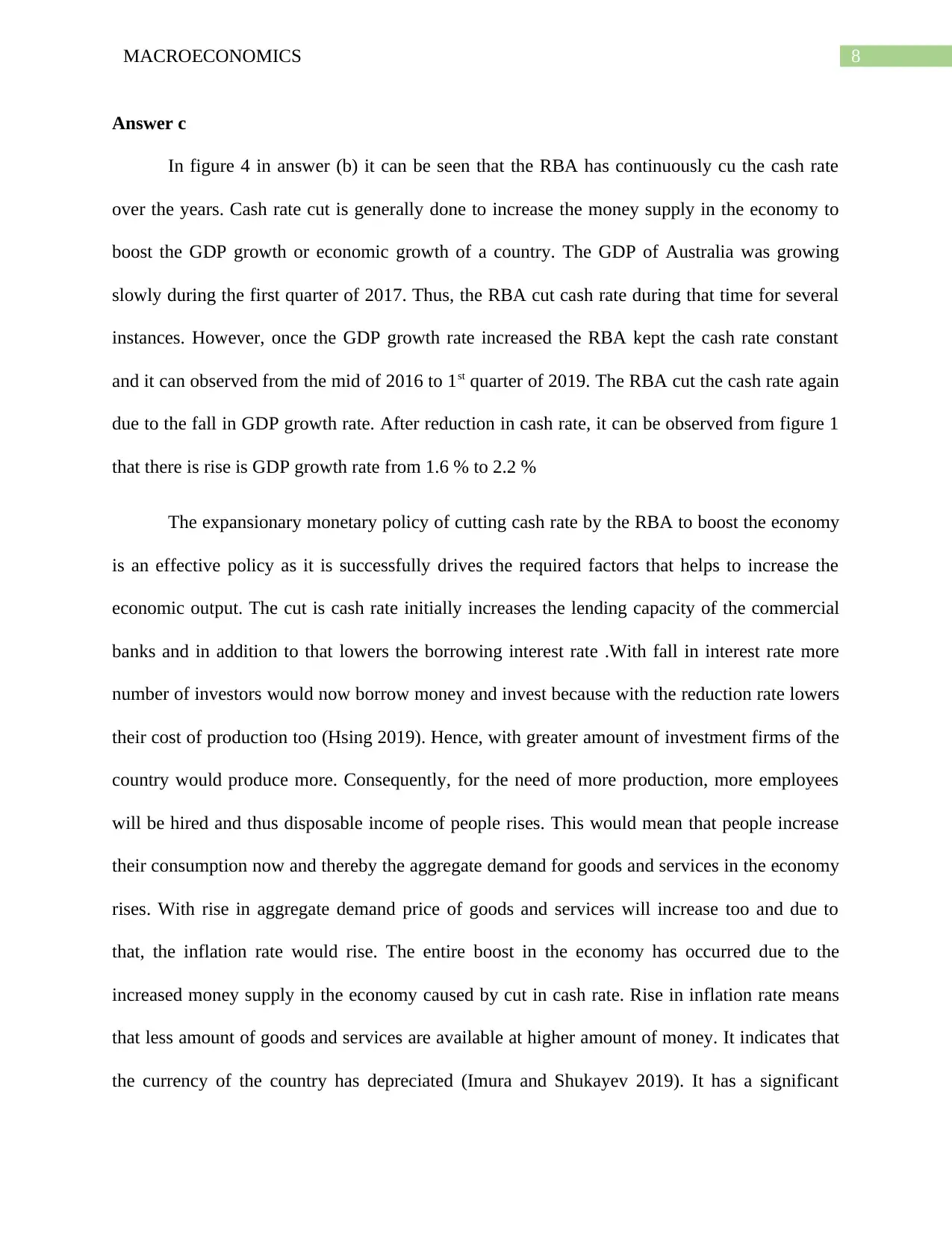
8MACROECONOMICS
Answer c
In figure 4 in answer (b) it can be seen that the RBA has continuously cu the cash rate
over the years. Cash rate cut is generally done to increase the money supply in the economy to
boost the GDP growth or economic growth of a country. The GDP of Australia was growing
slowly during the first quarter of 2017. Thus, the RBA cut cash rate during that time for several
instances. However, once the GDP growth rate increased the RBA kept the cash rate constant
and it can observed from the mid of 2016 to 1st quarter of 2019. The RBA cut the cash rate again
due to the fall in GDP growth rate. After reduction in cash rate, it can be observed from figure 1
that there is rise is GDP growth rate from 1.6 % to 2.2 %
The expansionary monetary policy of cutting cash rate by the RBA to boost the economy
is an effective policy as it is successfully drives the required factors that helps to increase the
economic output. The cut is cash rate initially increases the lending capacity of the commercial
banks and in addition to that lowers the borrowing interest rate .With fall in interest rate more
number of investors would now borrow money and invest because with the reduction rate lowers
their cost of production too (Hsing 2019). Hence, with greater amount of investment firms of the
country would produce more. Consequently, for the need of more production, more employees
will be hired and thus disposable income of people rises. This would mean that people increase
their consumption now and thereby the aggregate demand for goods and services in the economy
rises. With rise in aggregate demand price of goods and services will increase too and due to
that, the inflation rate would rise. The entire boost in the economy has occurred due to the
increased money supply in the economy caused by cut in cash rate. Rise in inflation rate means
that less amount of goods and services are available at higher amount of money. It indicates that
the currency of the country has depreciated (Imura and Shukayev 2019). It has a significant
Answer c
In figure 4 in answer (b) it can be seen that the RBA has continuously cu the cash rate
over the years. Cash rate cut is generally done to increase the money supply in the economy to
boost the GDP growth or economic growth of a country. The GDP of Australia was growing
slowly during the first quarter of 2017. Thus, the RBA cut cash rate during that time for several
instances. However, once the GDP growth rate increased the RBA kept the cash rate constant
and it can observed from the mid of 2016 to 1st quarter of 2019. The RBA cut the cash rate again
due to the fall in GDP growth rate. After reduction in cash rate, it can be observed from figure 1
that there is rise is GDP growth rate from 1.6 % to 2.2 %
The expansionary monetary policy of cutting cash rate by the RBA to boost the economy
is an effective policy as it is successfully drives the required factors that helps to increase the
economic output. The cut is cash rate initially increases the lending capacity of the commercial
banks and in addition to that lowers the borrowing interest rate .With fall in interest rate more
number of investors would now borrow money and invest because with the reduction rate lowers
their cost of production too (Hsing 2019). Hence, with greater amount of investment firms of the
country would produce more. Consequently, for the need of more production, more employees
will be hired and thus disposable income of people rises. This would mean that people increase
their consumption now and thereby the aggregate demand for goods and services in the economy
rises. With rise in aggregate demand price of goods and services will increase too and due to
that, the inflation rate would rise. The entire boost in the economy has occurred due to the
increased money supply in the economy caused by cut in cash rate. Rise in inflation rate means
that less amount of goods and services are available at higher amount of money. It indicates that
the currency of the country has depreciated (Imura and Shukayev 2019). It has a significant
⊘ This is a preview!⊘
Do you want full access?
Subscribe today to unlock all pages.

Trusted by 1+ million students worldwide
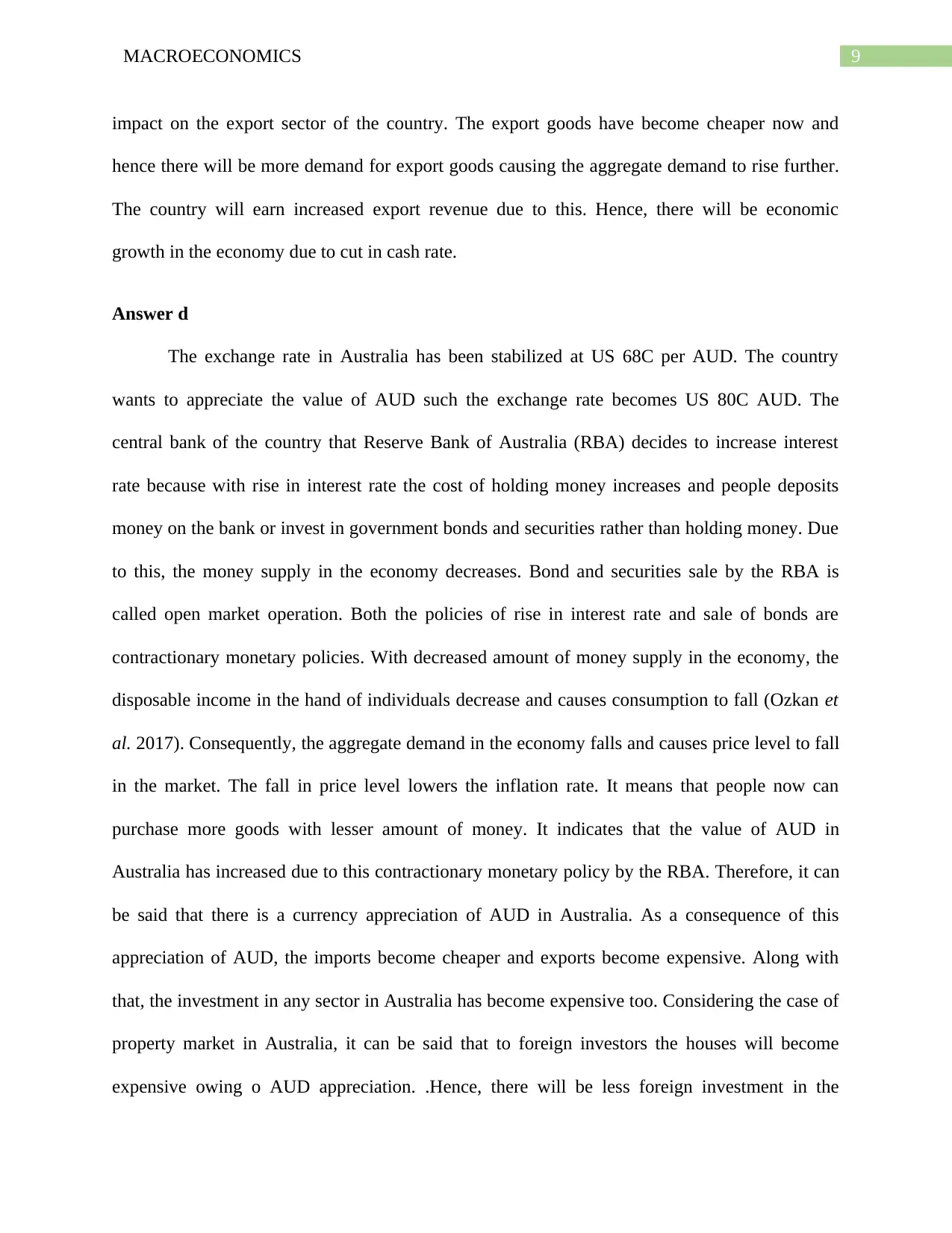
9MACROECONOMICS
impact on the export sector of the country. The export goods have become cheaper now and
hence there will be more demand for export goods causing the aggregate demand to rise further.
The country will earn increased export revenue due to this. Hence, there will be economic
growth in the economy due to cut in cash rate.
Answer d
The exchange rate in Australia has been stabilized at US 68C per AUD. The country
wants to appreciate the value of AUD such the exchange rate becomes US 80C AUD. The
central bank of the country that Reserve Bank of Australia (RBA) decides to increase interest
rate because with rise in interest rate the cost of holding money increases and people deposits
money on the bank or invest in government bonds and securities rather than holding money. Due
to this, the money supply in the economy decreases. Bond and securities sale by the RBA is
called open market operation. Both the policies of rise in interest rate and sale of bonds are
contractionary monetary policies. With decreased amount of money supply in the economy, the
disposable income in the hand of individuals decrease and causes consumption to fall (Ozkan et
al. 2017). Consequently, the aggregate demand in the economy falls and causes price level to fall
in the market. The fall in price level lowers the inflation rate. It means that people now can
purchase more goods with lesser amount of money. It indicates that the value of AUD in
Australia has increased due to this contractionary monetary policy by the RBA. Therefore, it can
be said that there is a currency appreciation of AUD in Australia. As a consequence of this
appreciation of AUD, the imports become cheaper and exports become expensive. Along with
that, the investment in any sector in Australia has become expensive too. Considering the case of
property market in Australia, it can be said that to foreign investors the houses will become
expensive owing o AUD appreciation. .Hence, there will be less foreign investment in the
impact on the export sector of the country. The export goods have become cheaper now and
hence there will be more demand for export goods causing the aggregate demand to rise further.
The country will earn increased export revenue due to this. Hence, there will be economic
growth in the economy due to cut in cash rate.
Answer d
The exchange rate in Australia has been stabilized at US 68C per AUD. The country
wants to appreciate the value of AUD such the exchange rate becomes US 80C AUD. The
central bank of the country that Reserve Bank of Australia (RBA) decides to increase interest
rate because with rise in interest rate the cost of holding money increases and people deposits
money on the bank or invest in government bonds and securities rather than holding money. Due
to this, the money supply in the economy decreases. Bond and securities sale by the RBA is
called open market operation. Both the policies of rise in interest rate and sale of bonds are
contractionary monetary policies. With decreased amount of money supply in the economy, the
disposable income in the hand of individuals decrease and causes consumption to fall (Ozkan et
al. 2017). Consequently, the aggregate demand in the economy falls and causes price level to fall
in the market. The fall in price level lowers the inflation rate. It means that people now can
purchase more goods with lesser amount of money. It indicates that the value of AUD in
Australia has increased due to this contractionary monetary policy by the RBA. Therefore, it can
be said that there is a currency appreciation of AUD in Australia. As a consequence of this
appreciation of AUD, the imports become cheaper and exports become expensive. Along with
that, the investment in any sector in Australia has become expensive too. Considering the case of
property market in Australia, it can be said that to foreign investors the houses will become
expensive owing o AUD appreciation. .Hence, there will be less foreign investment in the
Paraphrase This Document
Need a fresh take? Get an instant paraphrase of this document with our AI Paraphraser
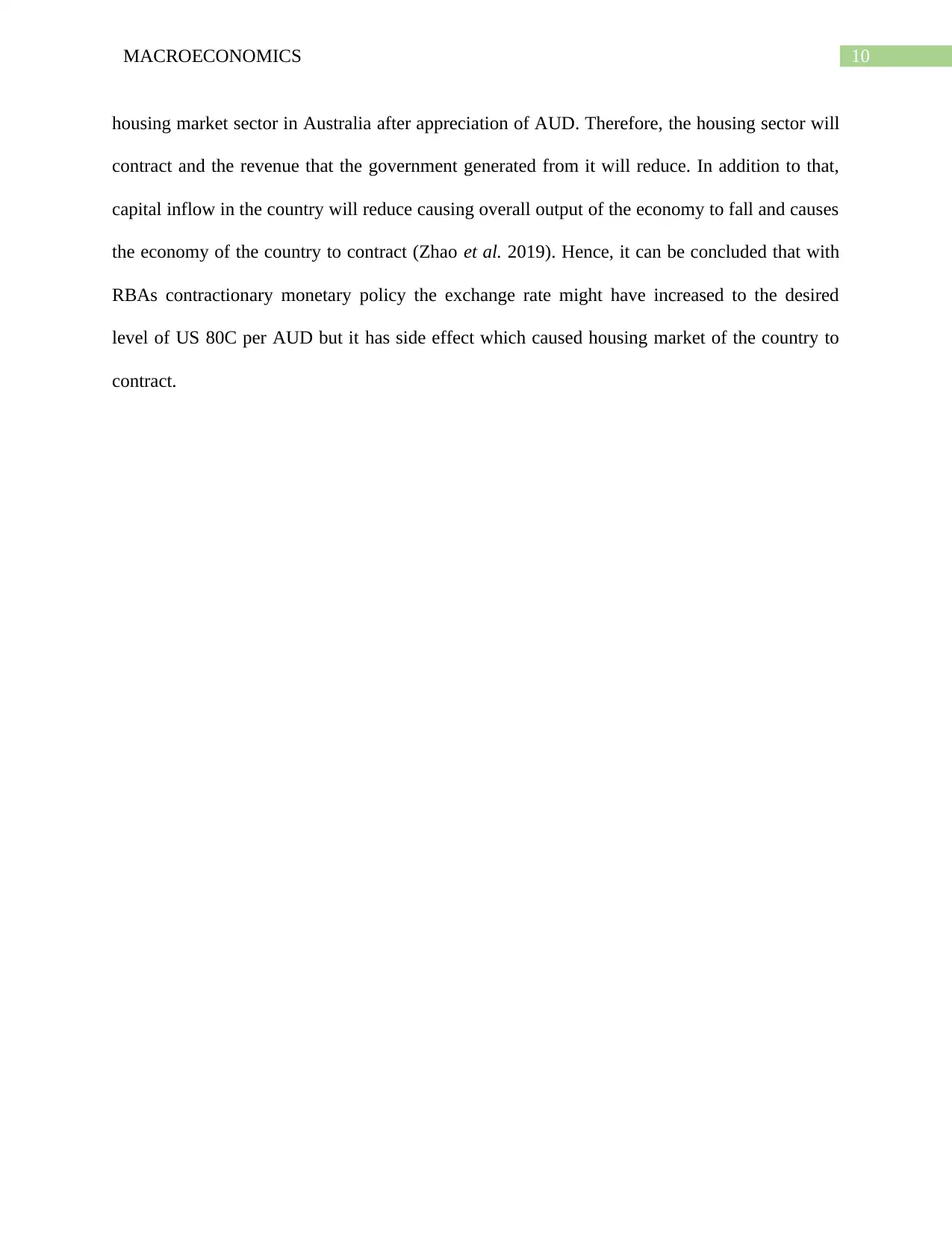
10MACROECONOMICS
housing market sector in Australia after appreciation of AUD. Therefore, the housing sector will
contract and the revenue that the government generated from it will reduce. In addition to that,
capital inflow in the country will reduce causing overall output of the economy to fall and causes
the economy of the country to contract (Zhao et al. 2019). Hence, it can be concluded that with
RBAs contractionary monetary policy the exchange rate might have increased to the desired
level of US 80C per AUD but it has side effect which caused housing market of the country to
contract.
housing market sector in Australia after appreciation of AUD. Therefore, the housing sector will
contract and the revenue that the government generated from it will reduce. In addition to that,
capital inflow in the country will reduce causing overall output of the economy to fall and causes
the economy of the country to contract (Zhao et al. 2019). Hence, it can be concluded that with
RBAs contractionary monetary policy the exchange rate might have increased to the desired
level of US 80C per AUD but it has side effect which caused housing market of the country to
contract.
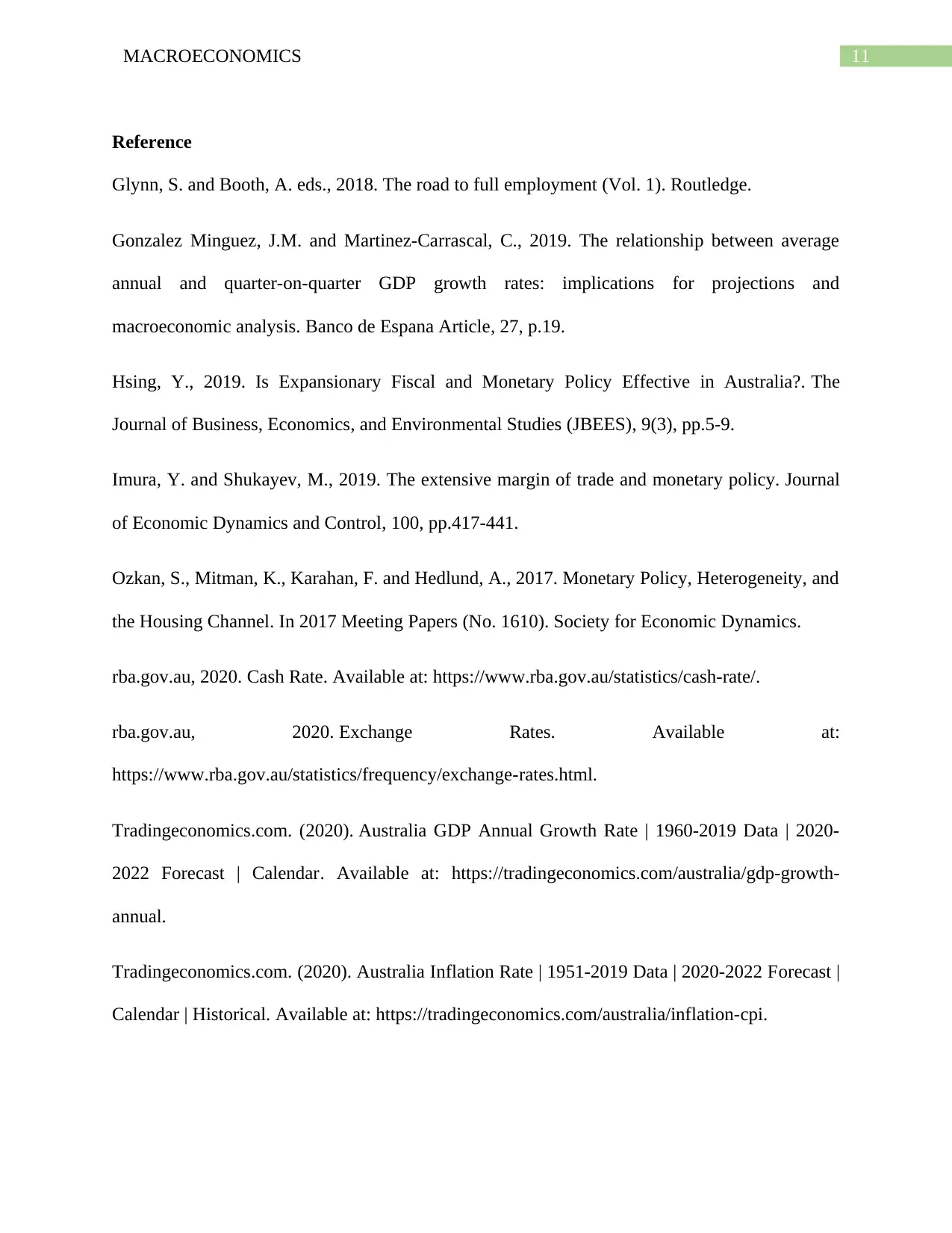
11MACROECONOMICS
Reference
Glynn, S. and Booth, A. eds., 2018. The road to full employment (Vol. 1). Routledge.
Gonzalez Minguez, J.M. and Martinez-Carrascal, C., 2019. The relationship between average
annual and quarter-on-quarter GDP growth rates: implications for projections and
macroeconomic analysis. Banco de Espana Article, 27, p.19.
Hsing, Y., 2019. Is Expansionary Fiscal and Monetary Policy Effective in Australia?. The
Journal of Business, Economics, and Environmental Studies (JBEES), 9(3), pp.5-9.
Imura, Y. and Shukayev, M., 2019. The extensive margin of trade and monetary policy. Journal
of Economic Dynamics and Control, 100, pp.417-441.
Ozkan, S., Mitman, K., Karahan, F. and Hedlund, A., 2017. Monetary Policy, Heterogeneity, and
the Housing Channel. In 2017 Meeting Papers (No. 1610). Society for Economic Dynamics.
rba.gov.au, 2020. Cash Rate. Available at: https://www.rba.gov.au/statistics/cash-rate/.
rba.gov.au, 2020. Exchange Rates. Available at:
https://www.rba.gov.au/statistics/frequency/exchange-rates.html.
Tradingeconomics.com. (2020). Australia GDP Annual Growth Rate | 1960-2019 Data | 2020-
2022 Forecast | Calendar. Available at: https://tradingeconomics.com/australia/gdp-growth-
annual.
Tradingeconomics.com. (2020). Australia Inflation Rate | 1951-2019 Data | 2020-2022 Forecast |
Calendar | Historical. Available at: https://tradingeconomics.com/australia/inflation-cpi.
Reference
Glynn, S. and Booth, A. eds., 2018. The road to full employment (Vol. 1). Routledge.
Gonzalez Minguez, J.M. and Martinez-Carrascal, C., 2019. The relationship between average
annual and quarter-on-quarter GDP growth rates: implications for projections and
macroeconomic analysis. Banco de Espana Article, 27, p.19.
Hsing, Y., 2019. Is Expansionary Fiscal and Monetary Policy Effective in Australia?. The
Journal of Business, Economics, and Environmental Studies (JBEES), 9(3), pp.5-9.
Imura, Y. and Shukayev, M., 2019. The extensive margin of trade and monetary policy. Journal
of Economic Dynamics and Control, 100, pp.417-441.
Ozkan, S., Mitman, K., Karahan, F. and Hedlund, A., 2017. Monetary Policy, Heterogeneity, and
the Housing Channel. In 2017 Meeting Papers (No. 1610). Society for Economic Dynamics.
rba.gov.au, 2020. Cash Rate. Available at: https://www.rba.gov.au/statistics/cash-rate/.
rba.gov.au, 2020. Exchange Rates. Available at:
https://www.rba.gov.au/statistics/frequency/exchange-rates.html.
Tradingeconomics.com. (2020). Australia GDP Annual Growth Rate | 1960-2019 Data | 2020-
2022 Forecast | Calendar. Available at: https://tradingeconomics.com/australia/gdp-growth-
annual.
Tradingeconomics.com. (2020). Australia Inflation Rate | 1951-2019 Data | 2020-2022 Forecast |
Calendar | Historical. Available at: https://tradingeconomics.com/australia/inflation-cpi.
⊘ This is a preview!⊘
Do you want full access?
Subscribe today to unlock all pages.

Trusted by 1+ million students worldwide
1 out of 13
Related Documents
Your All-in-One AI-Powered Toolkit for Academic Success.
+13062052269
info@desklib.com
Available 24*7 on WhatsApp / Email
![[object Object]](/_next/static/media/star-bottom.7253800d.svg)
Unlock your academic potential
Copyright © 2020–2025 A2Z Services. All Rights Reserved. Developed and managed by ZUCOL.




